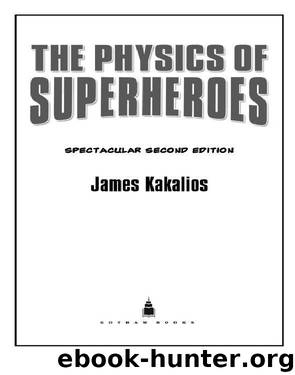The Physics of Superheroes: Spectacular Second Edition by Kakalios James

Author:Kakalios, James
Language: eng
Format: epub
Publisher: PENGUIN group
18
HOW ELECTRO BECOMES MAGNETO WHEN HE RUNS—AMPERE’S LAW
I SUPPOSE THAT we should cut Lee and Ditko some slack for their goof described in the previous chapter concerning whether metals can carry an electrical current if they’re not connected to ground. The rush to put out a monthly comic book, combined with the need to tell an exciting story, has certainly accounted for more than a few science blunders at both Marvel and DC over the years. As emphasized earlier, these comic-book tales were never meant to serve as physics textbooks. It is therefore all the more impressive that in the very same issue of Amazing Spider-Man that features Electro’s debut, we see a perfect illustration of one of the fundamental properties of electricity.
At one point in the story, following a brazen daytime bank robbery, Electro is shown escaping from the authorities by climbing up the side of a building, as easily as Spider-Man. The panel is reproduced on p. 197 in fig. 25, where we see one observer exclaim, “Look!! That strangely-garbed man is racing up the side of the building!” A second man on the street picks up the narrative: “He’s holding on to the iron beams in the building by means of electric rays—using them like a magnet!! Incredible!”
There are three feelings inspired by this scene. The first is wonder as to why people rarely use the phrase “strangely-garbed” anymore. The second is nostalgia for the bygone era when pedestrians would routinely narrate events occurring in front of them, providing exposition for any casual bystander. And the third is pleasure at the realization that Electro’s climbing this building is actually a physically plausible use of his powers. Utility-pole man Max Dillon (Electro) understands, as does the second passerby in the panel, that electric currents do indeed create magnetic fields. This phenomenon, termed the Ampere effect, was first noted by Hans Christian Øersted (for whom a unit of magnetic-field strength is named) and was fully explained by André-Marie Ampère (after whom the unit of electrical current, the “amp,” is named). Why does Electro’s control of electricity enable him to generate magnetic fields, and wouldn’t fairness therefore dictate that Magneto, the mutant master of magnetism, be able to control electric currents at will? The answer to this question reveals a deep symmetry between electricity and magnetism, found in both comic books and the real world.
We first must begin by defining an “electric field.” An electric charge at rest exerts a force on another electric charge. The farther away this second charge is, the weaker the force and, depending on its polarity, the second charge will be either pulled toward or pushed away from the first electric charge. We can therefore say that there is a “zone of force” surrounding this first electric charge. Another way to describe this “zone of force” is to say that around the first charge is an “electric field.” A second electric charge brought near the first charge will experience a force as it is being pushed or pulled by the electric field of the first charge.
Download
This site does not store any files on its server. We only index and link to content provided by other sites. Please contact the content providers to delete copyright contents if any and email us, we'll remove relevant links or contents immediately.
The Complete Stick Figure Physics Tutorials by Allen Sarah(7336)
Secrets of Antigravity Propulsion: Tesla, UFOs, and Classified Aerospace Technology by Ph.D. Paul A. Laviolette(5332)
Thing Explainer by Randall Munroe(3909)
The River of Consciousness by Oliver Sacks(3572)
The Order of Time by Carlo Rovelli(3162)
How To by Randall Munroe(3074)
A Brief History of Time by Stephen Hawking(2991)
I Live in the Future & Here's How It Works by Nick Bilton(2959)
What If?: Serious Scientific Answers to Absurd Hypothetical Questions by Randall Munroe(2667)
The Great Unknown by Marcus du Sautoy(2662)
Midnight in Chernobyl by Adam Higginbotham(2515)
Blockchain: Ultimate Step By Step Guide To Understanding Blockchain Technology, Bitcoin Creation, and the future of Money (Novice to Expert) by Keizer Söze(2467)
Networks: An Introduction by Newman Mark(2382)
The Meaning of it All by Richard Feynman(2318)
Easy Electronics by Charles Platt(2308)
The Tao of Physics by Fritjof Capra(2247)
Midnight in Chernobyl: The Untold Story of the World's Greatest Nuclear Disaster by Adam Higginbotham(2195)
When by Daniel H Pink(2098)
Introducing Relativity by Bruce Bassett(2097)
